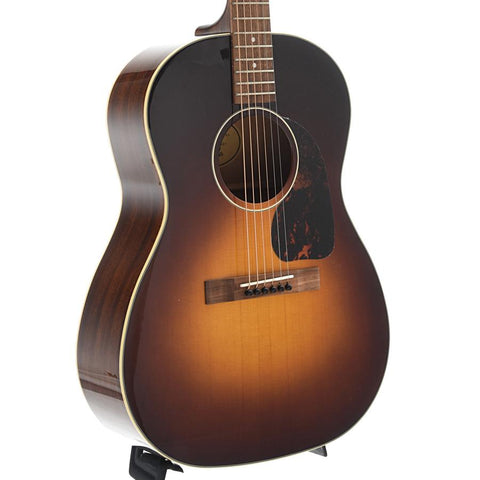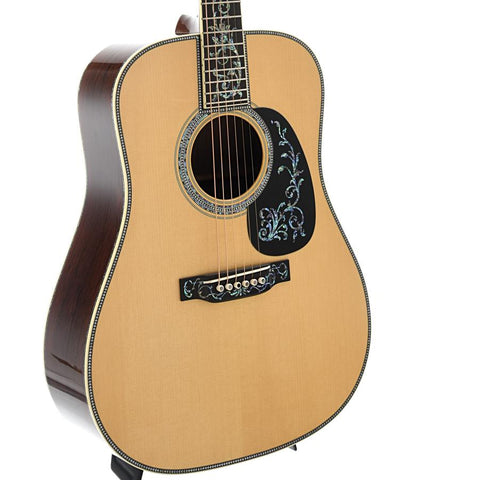So you’ve decided to buy your first acoustic guitar. That’s great! But picking out a new guitar can be a daunting task for seasoned professionals, let alone guitar newbies. Here at Elderly Instruments, we have over 500 flat top acoustic guitars in stock, not to mention a variety of acoustic archtops, resonator guitars, classical guitars, and other specialty instruments.
Where does one even begin? Well, the first step is to set a budget. Once you know how much you want to spend, you can start comparing guitars in that price range. We’ve put together a list of 7 questions that should help you find a guitar that fits your style and needs.
1. Laminated or solid wood?
One of the first decisions you will need to make is laminated versus solid wood in the guitar body. Guitar tops, backs, and sides can be made from solid wood or from several layers of thin wood that are glued together (laminated). Solid wood instruments sound better and will mature over time, but that doesn’t mean you should entirely rule out instruments made with laminated wood.
Laminated wood instruments are usually less expensive, which means they can be a nice choice for anyone who wants to start playing without making a big investment up front. Laminated wood instruments are also less susceptible to changes in temperature and humidity. If you want a guitar to take on road trips or to music festivals where the instrument might have to endure extreme temperatures, a laminated wood instrument could be a good option.

The Farida Old Town Series OT-22 features a classic tonewood combination. The top is solid spruce, and the back and sides are laminated mahogany.
You can also find a lot of guitars with solid tops and laminated backs and sides. This can strike a nice balance, as you get the improved tone quality of the solid top with the durability of laminated back and sides, and it will still be less expensive than most all solid wood guitars.
2. Does the kind of wood really matter?
The types woods used to make the body, known as tonewoods, have a significant effect on the guitar’s sound. Probably the most important detail in determining a guitar’s overall sound is the tonewood used for the top. The most common wood for guitar tops is spruce, which is valued for its clarity and balance. Another popular option is mahogany (usually paired with mahogany back and sides), which provides warm, responsive tone. Occasionally you’ll see guitars with cedar tops, which offer lush, balanced tone, or koa (often paired with koa back and sides), which has a sweet, complex tone.
The most common woods for backs and sides are mahogany and rosewood. Mahogany backs and sides can add warmth to a spruce top, and there are also a fair number of all-mahogany guitars on the market, which offer a warm, mellow tone. Rosewood is highly valued as a tonewood because of its rich, chiming tone. Quality rosewood is getting harder to find, however, and international treaties are making it more difficult to buy and sell rosewood or rosewood goods — like guitars — internationally. This is at least part of the reason for the growing popularity of less expensive rosewood alternatives like pau ferro. Sapele is also gaining popularity as an alternative to mahogany.
To learn more about some of the most popular tonewood combinations, check out the video below:
Tonewood preferences are subjective, of course, so it’s best to try them out in person if you have the opportunity. If you’re buying your first guitar, a tried-and-true combination like spruce and mahogany is a nice place to start, and you can swap it for something else later as you develop your tonewood preferences.
3. Is bigger always better?
When you’re thinking about body sizes, you want to consider two things: tone and comfort. Let’s start with tone.
Dreadnought sized guitars, some of the largest on the market, will provide excellent bass response and significant volume. Another full size option is the 000 guitar, which retains some of the punch and volume of a dreadnought but with a more balanced sound overall. Smaller guitars, like 0 or parlor sized guitars, tend to have a more intimate, balanced sound. Different makers use different names for their guitar sizes, but you can learn about some of the most popular sizes in the video below:
Now let’s consider comfort. Smaller players, especially children, will probably find small guitars more comfortable. 0 size guitars are a good option, or you may want to consider a short scale instrument like a Baby Taylor, Little Martin, or 3/4 size guitar. These guitars are shorter overall, meaning it’s less of a reach to the lowest frets. Larger players, on the other hand, will likely feel more comfortable on a larger guitar like a dreadnought.
4. That guitar has a lot of bling -- it must be better, right?
There are a lot of details on a guitar that are entirely or mostly aesthetic. Fancy fretboard inlays or decorative rosettes around the soundhole, for example, can make a guitar look more interesting, but it won’t really affect the tone or playability in any measurable way. The same goes for sunburst or other colored finishes on the guitar body. Pickguards fall somewhere in the middle -- they can protect your guitar top from heavy strumming, but they don’t have much of an effect on the overall tone of a guitar.
Looks aren’t everything, but you want an instrument that you enjoy spending time with, and having a guitar that fits your style can improve the overall experience.

Flashy appointments like fretboard inlays, purfling, and rosettes can give a guitar some visual appeal, but they won't noticeably affect the guitar's sound.
5. Do I need a pickup?
It depends on what you want to do with your guitar. If you only plan to play acoustically with friends or around the house, you may never need a pickup. If you’re going to be playing around town, even small venues like coffee houses, open mics, or churches, a pickup can make life a lot easier for you. A pickup allows you to plug into an amplifier or PA system without having to mess with fussy external microphones.
Many acoustic guitars come with a factory installed pickup system, but we also sell a variety of aftermarket pickups that can be installed later. If you fall in love with an instrument that doesn’t have a pickup, this is a nice option. Some pickups are temporary and easy to install, while others are semi-permanent and may require professional installation. This work can be done in our expert repair department.
6. How much upkeep do I have to worry about?
Two of the biggest threats to acoustic instruments are temperature and humidity. Extremes in temperature or humidity can warp the wood on your guitar, making it difficult to play and potentially damaging the instrument. Check out this blog post on humidification to learn more about keeping your instrument happy and healthy.
Cleaning your guitar also helps its longevity. After playing, clean all metal parts -- especially machine heads, strings, and frets -- with a clean, dry, and soft cloth. Skin acids and oils will take the shine off of metal plating and can lead to corrosion. Glossy finish woods should be cleaned with silicon-free guitar polish liquid, while satin finish woods should not be cleaned with polishing liquids. Just use a soft, clean, and dry cloth.
The fingerboard loses its natural oil over time. It may look dry and it can even shrink, causing fret ends to appear sharp. Use raw linseed oil and rub it into the wood with a clean, lint-free cloth. Let the fingerboard soak up the oil before wiping off any excess.
7. Is guitar set up important?
Having your guitar set up properly can greatly improve your playing experience. It’s like taking your instrument in for a tune-up. The repair technician will check several things, like making sure that the neck is straight, that the bridge is the proper height, that strings are the right distance from the fretboard, and that intonation is consistent across the entire fingerboard.
Guitars that are not properly set up may be difficult to play, because the strings are too far away from the fretboard, requiring more effort to press them down. Or if the strings are too low, you may notice buzzing or other unwanted noise. Almost every instrument that comes through our store is set up in our repair department, so that when you pick it up in the showroom or it arrives in the mail, it’s ready to rock. (Some used items and a few budget model ukuleles are sold AS-IS, with no set up or repair work done. In those cases, we do our best to let you know about work that needs to be done.)
Guitars woods will change in response to temperature, humidity, and time, so you will want to periodically have your guitar set up. We recommend having your guitar set up every six months. A motivated do-it-yourself-er can get the tools to do set ups at home, but most players bring their guitar to a reputable shop or repair technician for set up work. Our repair shop not only provides excellent service, they can also help spot potential problems or suggest possible upgrades that you may not be aware of.
Let’s go!
Buying your first guitar can be intimidating, so we hope this blog post gives you some helpful tips to help you narrow down your options. And if you have more questions, you can always call our helpful sales department at (517) 372-7890. Don’t forget the most important advice: Have fun! Picking a guitar is a big decision, but it’s not a lifetime commitment. Find a guitar that fits your style and budget as best you can, and there will be opportunities to get a new instrument down the road if you decide to try something different.
